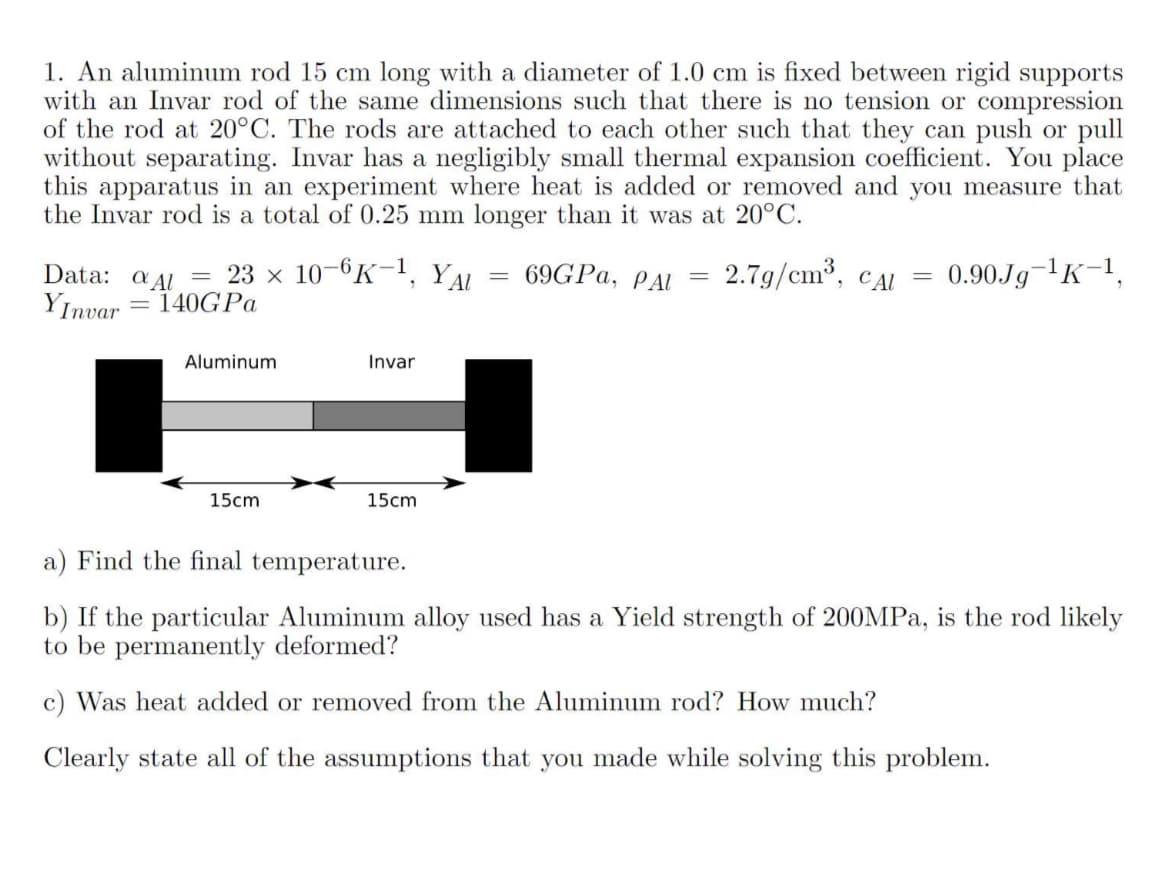1. An aluminum rod 15 cm long with a diameter of 1.0 cm is fixed between rigid supports with an Invar rod of the same dimensions such that there is no tension or compression of the rod at 20°C. The rods are attached to each other such that they can push or pull without separating. Invar has a negligibly small thermal expansion coefficient. You place this apparatus in an experiment where heat is added or removed and you measure that the Invar rod is a total of 0.25 mm longer than it was at 20°C. 2.7g/cm³, CAL = 0.90Jg-¹K-1, Data: aA = 23 x 10-6K-1, YAL YInvar = 140G Pa Aluminum 15cm Invar 15cm = 69GPa, PAL = a) Find the final temperature. b) If the particular Aluminum alloy used has a Yield strength of 200MPa, is the rod likely to be permanently deformed? c) Was heat added or removed from the Aluminum rod? How much? Clearly state all of the assumptions that you made while solving this problem.
1. An aluminum rod 15 cm long with a diameter of 1.0 cm is fixed between rigid supports with an Invar rod of the same dimensions such that there is no tension or compression of the rod at 20°C. The rods are attached to each other such that they can push or pull without separating. Invar has a negligibly small thermal expansion coefficient. You place this apparatus in an experiment where heat is added or removed and you measure that the Invar rod is a total of 0.25 mm longer than it was at 20°C. 2.7g/cm³, CAL = 0.90Jg-¹K-1, Data: aA = 23 x 10-6K-1, YAL YInvar = 140G Pa Aluminum 15cm Invar 15cm = 69GPa, PAL = a) Find the final temperature. b) If the particular Aluminum alloy used has a Yield strength of 200MPa, is the rod likely to be permanently deformed? c) Was heat added or removed from the Aluminum rod? How much? Clearly state all of the assumptions that you made while solving this problem.
Principles of Heat Transfer (Activate Learning with these NEW titles from Engineering!)
8th Edition
ISBN:9781305387102
Author:Kreith, Frank; Manglik, Raj M.
Publisher:Kreith, Frank; Manglik, Raj M.
Chapter5: Analysis Of Convection Heat Transfer
Section: Chapter Questions
Problem 5.36P
Related questions
Question

Transcribed Image Text:1. An aluminum rod 15 cm long with a diameter of 1.0 cm is fixed between rigid supports
with an Invar rod of the same dimensions such that there is no tension or compression
of the rod at 20°C. The rods are attached to each other such that they can push or pull
without separating. Invar has a negligibly small thermal expansion coefficient. You place
this apparatus in an experiment where heat is added or removed and you measure that
the Invar rod is a total of 0.25 mm longer than it was at 20°C.
69GPa, PAL = 2.7g/cm³, CAL = 0.90Jg-¹K-1,
Data: A = 23 × 10-6K-1, YAL
YInvar = 140G Pa
Aluminum
15cm
Invar
15cm
=
a) Find the final temperature.
b) If the particular Aluminum alloy used has a Yield strength of 200MPa, is the rod likely
to be permanently deformed?
c) Was heat added or removed from the Aluminum rod? How much?
Clearly state all of the assumptions that you made while solving this problem.
Expert Solution
This question has been solved!
Explore an expertly crafted, step-by-step solution for a thorough understanding of key concepts.
Step by step
Solved in 3 steps with 3 images

Knowledge Booster
Learn more about
Need a deep-dive on the concept behind this application? Look no further. Learn more about this topic, mechanical-engineering and related others by exploring similar questions and additional content below.Recommended textbooks for you

Principles of Heat Transfer (Activate Learning wi…
Mechanical Engineering
ISBN:
9781305387102
Author:
Kreith, Frank; Manglik, Raj M.
Publisher:
Cengage Learning

Principles of Heat Transfer (Activate Learning wi…
Mechanical Engineering
ISBN:
9781305387102
Author:
Kreith, Frank; Manglik, Raj M.
Publisher:
Cengage Learning